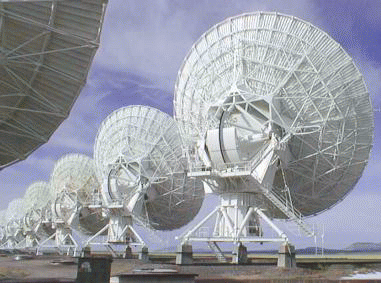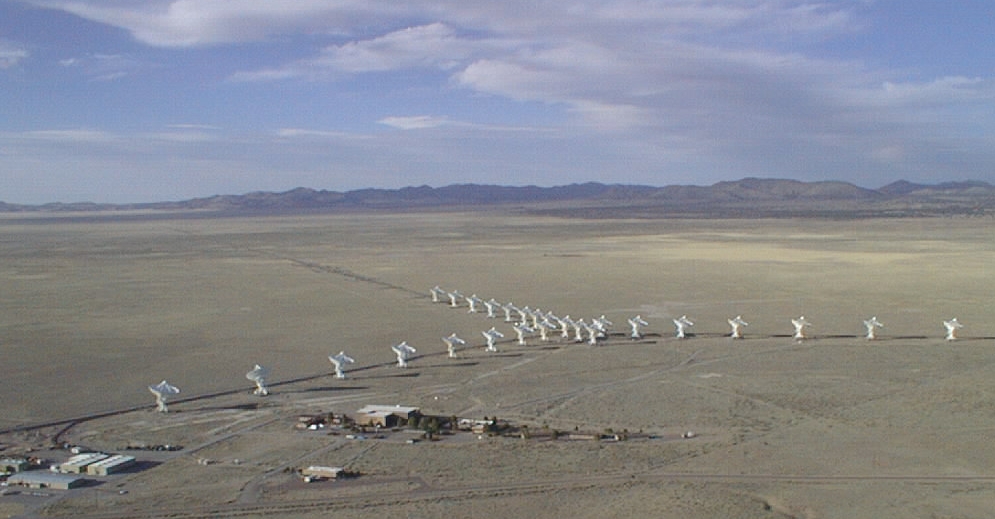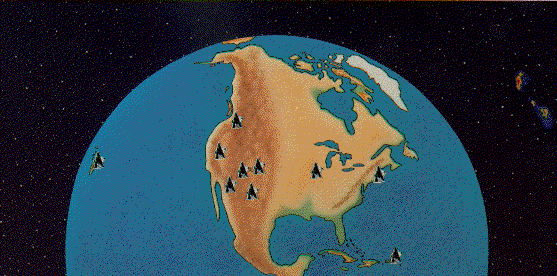
| The Very Large Array | |

| The Very Large Array (VLA) is an amazingly powerful instrument, with each of its 27 antennas having a parabolic reflecting surface of diameter 25 meters an a figure accurate enough to allow operation to wavelengths as short as 7mm! The antennas may be moved into configurations along railroad tracks - the widest configuration is the "A" array where the outermost antennas are 45 km apart. The antennas are placed on concrete pads (seen above) along the tracks, which extend from the array center in a "Y" pattern, seen below: |

| This is a shot of the VLA in its "D" configuration, where the antennas are packed together closely in order to maximise the sensitivity to extended diffuse astronomical phenomea, such as interstellar clouds and the nebulous lobes of radio galaxies. |
| For more information on the VLA, see the VLA Home Page. |
| As powerful as the VLA is, it was built in the 1970s and much of its underlying technology is now out of date, especially the correlator system that combines ("interferes") the data from the individual antennas together in order to produce the information needed to make astronomical images and the waveguides that connect the antennas together. Therefore, one of the high priorites in the coming decade is to upgrade the VLA to the improved technology of today, giving it a boost in sensitivity of a factor of 10-100, and in essence making it a whole new instrument - the Ultra Sensitive Array! |
| For more information on the VLA Upgrade and the Ultra Sensitive Array, see the VLA Upgrade Home Page. |

| The VLA also is apart of a larger array of telescope spanning the continental US (plus Hawaii and Virgin Islands) - the Very Long Baseline Array (VLBA). The VLBA forms interferometric images by recording the signals received at each of the telescopes on special computer tapes, which are then brought together at the main VLBA center in Socorro, New Mexico, where they are played back into the "correlator" and "interfered" to make the images. Because the telescopes are spread over the whole of our country, the VLBA images have the sharpness ("resolution") that would be produced by a telescope of the diameter of our continent - nearly 4000 miles! The VLBA also works with radio telescopes around the world as a Global Array and even with the HALCA satellite in Earth orbit for Space VLBI! |
| One of the goals of the VLA Upgrade project is to construct new antennas within 200 km of the VLA which can be used with either the VLBA or with the VLA directly. These telescopes will allow the VLA and VLBA to operate seamlessly as a continental telescope to realize the superb high-resolution imaging potential of the VLA and VLBA together. |
| For more information on the VLBA, see the VLBA Home Page. To see the antennas and locations of the VLBA, see the VLBA Site Guide. |
| Images courtesy Associated Universities Inc. and the National Radio Astronomy Observatory. Text by Steven T. Myers 1999. |